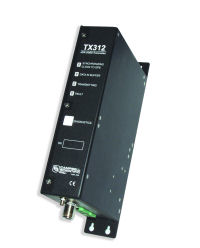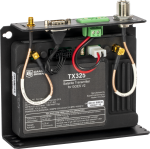This product is not available for new orders. We recommend ordering: TX321.

| Services Available | |
|---|---|
| Repair | No |
| Calibration | No |
| Free Support | No |
Overview
The TX312 is a satellite transmitter that uses the GOES satellite system to provide one-way communications from a data collection platform (DCP) to a receiving station. The TX312 complies with the High Data Rate (HDR) specifications and supports transmission rates of 100, 300, and 1200 bps.
Note: Services and support are no longer available for the TX312.
Read MoreBenefits and Features
- NESDIS certification in process
- Automatic GPS correction of clock and oscillator drift
- Operates up to 28 days between GPS fixes
- Independent self-timed and random data buffers
- Diagnostics and status information can be sampled by the data logger and transmitted as part of the data stream
- Available on GSA MAS Contract Number GS-25F-6042D
- Readily added or retrofitted to existing Campbell Scientific systems
- Non-volatile setups configured with Windows-based software
Images

Similar Products
Detailed Description
The TX312 uses the GOES satellite system to provide one-way communications from a data collection platform (DCP) to a receiving station. This satellite transmitter complies with the High Data Rate (HDR) specifications. Supported transmission rates are 100, 300, and 1200 bps. Because clock accuracy is critically important for GOES satellite telemetry, the TX312 includes a robust, TCXO-based real-time clock and a GPS receiver. The TX312 is compatible with most of our data loggers. (See the Compatibility information.)
GOES System
The GOES system is administered by the National Environmental Satellite Data Information Service (NESDIS). NESDIS assigns addresses, uplink channels, and self-timed/random transmit time windows. Self-timed windows allow data transmission only during a predetermined time frame. Random windows are for applications of a critical nature (e.g., flood reporting) and allow transmission immediately after a threshold has been exceeded.
TX312 and SAT HDR GOES ComparisonThe TX312 replaced the SAT HDR GOES in 2005. The TX312 provides the following advantages over its predecessor, the SAT HDR GOES:
|
Compatibility
Note: The following shows notable compatibility information. It is not a comprehensive list of all compatible or incompatible products.
Data Loggers
| Product | Compatible | Note |
|---|---|---|
| 21X (retired) | ||
| CR10 (retired) | The CR10 requires a special PROM. | |
| CR1000 (retired) | ||
| CR10X (retired) | ||
| CR200 (retired) | ||
| CR200X (retired) | ||
| CR205 (retired) | ||
| CR206 (retired) | ||
| CR206X (retired) | ||
| CR210 (retired) | ||
| CR211 (retired) | ||
| CR211X (retired) | ||
| CR215 (retired) | ||
| CR216 (retired) | ||
| CR216X (retired) | ||
| CR23X (retired) | ||
| CR295 (retired) | ||
| CR295X (retired) | ||
| CR3000 (retired) | ||
| CR500 (retired) | ||
| CR5000 (retired) | ||
| CR510 (retired) | ||
| CR800 (retired) | ||
| CR850 (retired) | ||
| CR9000 (retired) | ||
| CR9000X (retired) |
Additional Compatibility Information
Environmental Enclosure
The TX312 transmitter should be housed in an ENC16/18 environmental enclosure. Customers can order the 19332 and 19336 Antenna Cable/Bulkhead accessories to have Campbell Scientific punch a special bulkhead hole in the enclosure and install 17” cables for the Yagi and GPS antennas.
Power Supply
Typical power supply is a BP12 12 Ahr or BP24 24 Ahr battery, CH100 regulator, and an SP10 or SP20 solar panel. A user-supplied deep-cycle rechargeable battery should be used when it is difficult to replace the batteries or the system's power requirements are large. The deep-cycle rechargeable battery should have at least a 60 Ahr capacity, and be trickle-charged with an 20 W solar panel.
Specifications
| Operating Voltage Range | 10.8 to 16 Vdc |
| Supply Current @ 12 Vdc |
|
| Transmission Data Rates | 100, 300, and 1200 bps |
| Channel Bandwidth |
|
| Output Power | Complies with NESDIS DCPRS Certification Standards, Section 4. For 1200 bps, it has a nominal EIRP of 51 dBm and a maximum EIRP of 53 dBm, assuming appropriate antenna. For 100/300 bps, it has a nominal EIRP of 48 dBm and a maximum EIRP of 50 dBm, assuming appropriate antenna. |
| Frequency Range | 401.7 MHz to 402.1 MHz |
| Dimensions | 27.7 x 5.3 x 16.2 cm (10.9 x 2.1 x 6.38 in.) |
| Weight | 0.95 kg (2.1 lb) |
Timekeeping |
|
| Setting Accuracy | ±100 µs (synchronized to GPS) |
| Drift | ±10 msec/day (over -40º to +60ºC) |
| GPS Schedule | 1 fix at power up, 1 fix per day afterwards |
| Transmission Continuation without GPS Fix | 28 days |
Frequency Stability |
|
| Initial Accuracy | ±20 Hz disciplined to GPS |
| GPS Schedule | 1 fix at power up, 1 fix per day afterward |
| Short-Term Drift | ±0.04 Hz/seconds |
| Aging | ±0.1 PPM/year |
| Vcc + Temperature | ±0.1 PPM |
Documents
Brochures
Downloads
Sat Commander v.11.3.8 (3.78 MB) 03-08-2011
TX312 Support Software.Case Studies
Competition for limited water resources in the western United States is increasing, as are the......read more
Privacy Policy Update
We've updated our privacy policy. Learn More
Cookie Consent
Update your cookie preferences. Update Cookie Preferences

